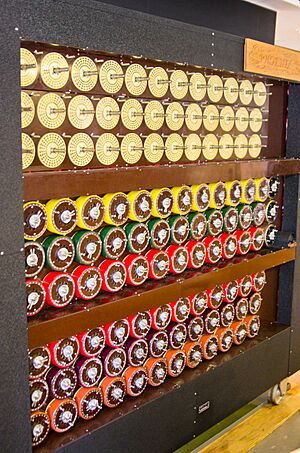Harold Keen facts for kids
Harold Hall "Doc" Keen (1894–1973) was a clever British engineer. He designed and helped build a special machine called the bombe. This machine was super important during World War II because it helped break secret German messages. These messages were sent using a machine called the Enigma machine. People called him "Doc" Keen because he carried his tools and papers in a bag that looked like a doctor's bag. After the war, he received a special award called the O.B.E. for his amazing work.
Contents
Harold Keen: The Engineer Who Broke Codes
Before the War: A Young Engineer's Start
Harold Keen was born in Shoreditch, east London, in 1894. When he was 18, he moved to Kentish Town and started studying Electrical Engineering. In 1912, he joined the British Tabulating Machine Company (BTM). This company brought in and put together American punched card machines.
In 1916, Keen joined the Royal Flying Corps. He worked on the ground staff for a bomber squadron in northern France. After the war, in 1919, he returned to BTM. He also married Eva Burningham that year.
In 1921, Keen moved with BTM to Letchworth in Hertfordshire. Two years later, he became the head of the Experimental Department. He was very good at creating new things. He became known as the best British inventor of punched-card technology. Keen was granted more than sixty patents for his inventions. By the 1930s, he was the Chief Engineer at BTM.
The Bombe: A Secret Weapon Against Enigma

Before 1939, Polish codebreakers had created a machine called the cryptologic bomb. This machine helped them break Enigma codes. However, it only worked when the Germans made certain mistakes in their procedures. The Germans slowly fixed these mistakes, making the Polish machine less useful.
Alan Turing, a brilliant British mathematician, designed a new kind of bombe. His design worked on a more general idea. It used something called a crib. A crib was a piece of text that codebreakers could guess would be in a message. For example, the Germans often used "ANX" (meaning "To," followed by "X" as a spacer). This technique helped them figure out the Enigma settings.
As the chief engineer at the British Tabulating Machine Company in Letchworth, Harold Keen was asked to build Turing's ideas into a real, working machine. The first bombe was installed at Bletchley Park on March 18, 1940. It was named "Victory."
The second bombe, called "Agnus dei" (later shortened to "Agnes" or "Aggie"), had an important new part. This was the diagonal board, designed by Gordon Welchman. It was installed on August 8, 1940. The "Victory" machine was later sent back to Letchworth to have a diagonal board added too.
How the Bombe Helped Win the War
During 1940, these two machines successfully broke 178 secret messages. To protect the bombes from possible bombing raids, five special outstations were set up. These were located at Adstock, Gayhurst, Wavendon, Stanmore, and Eastcote.
Group Captain Winterbotham called the bombe a "Bronze Goddess" because of its color. However, the people who operated the machines described them more simply. They said the bombes looked "like great big metal bookcases." These machines were vital in helping the Allies understand German plans during the war.
See also
- Cryptanalysis of the Enigma — more about how the Enigma code was broken, including Harold Keen's part
- Ultra — information about the secret intelligence gained from breaking Enigma and cryptanalysis of the Lorenz cipher
- Joseph Desch — the person who led the project to design and build the US Navy's version of the Bombe

